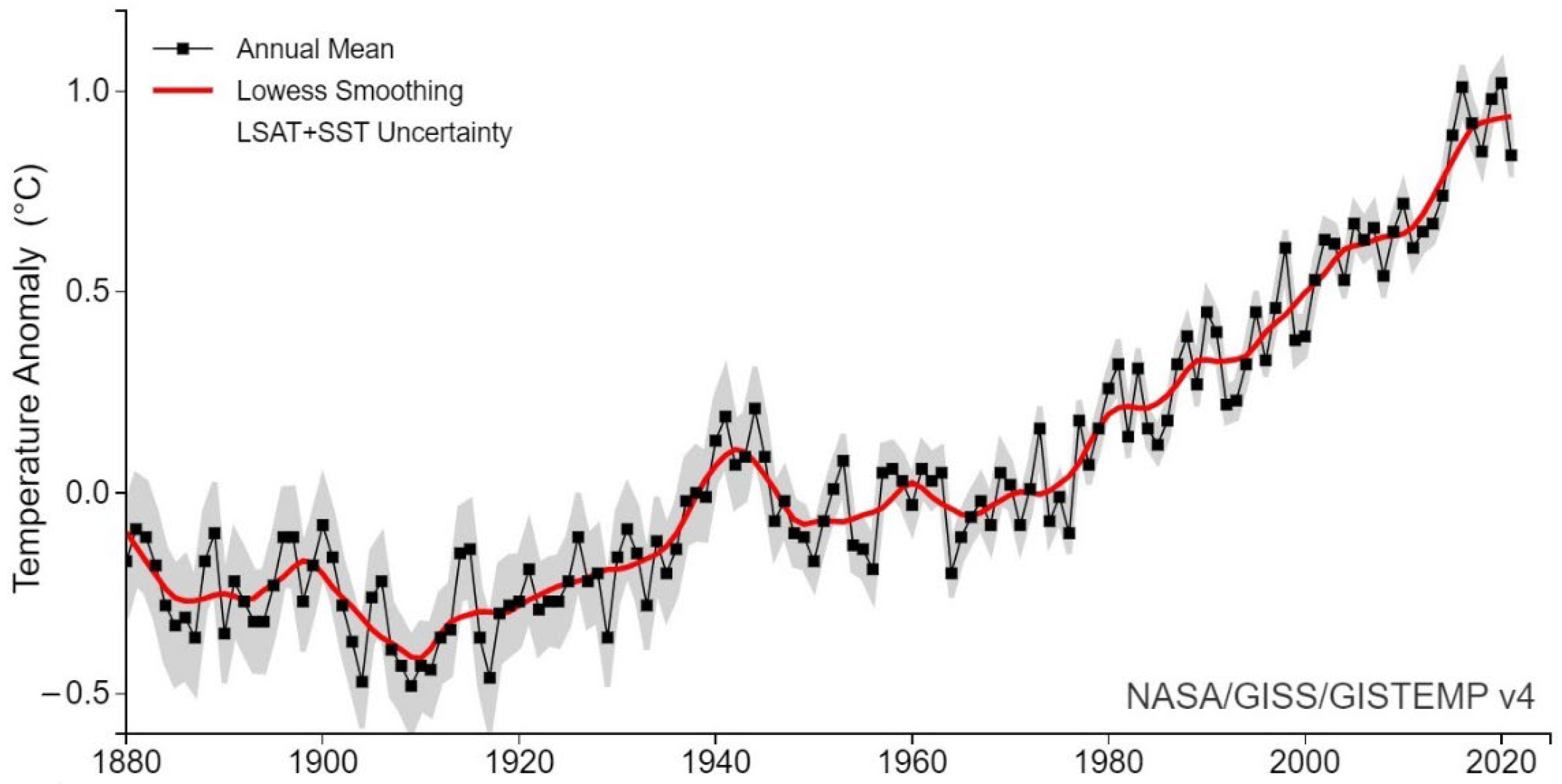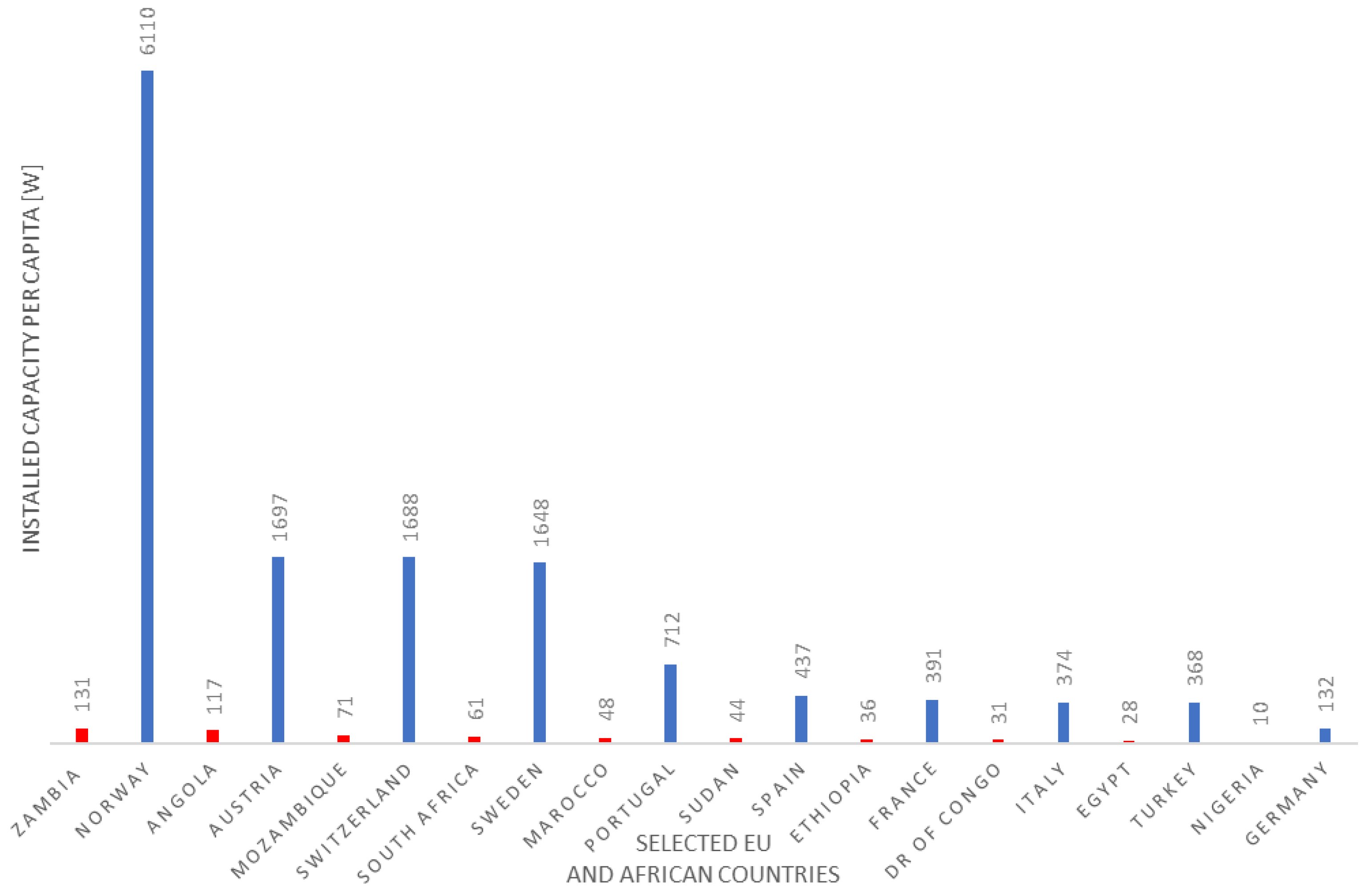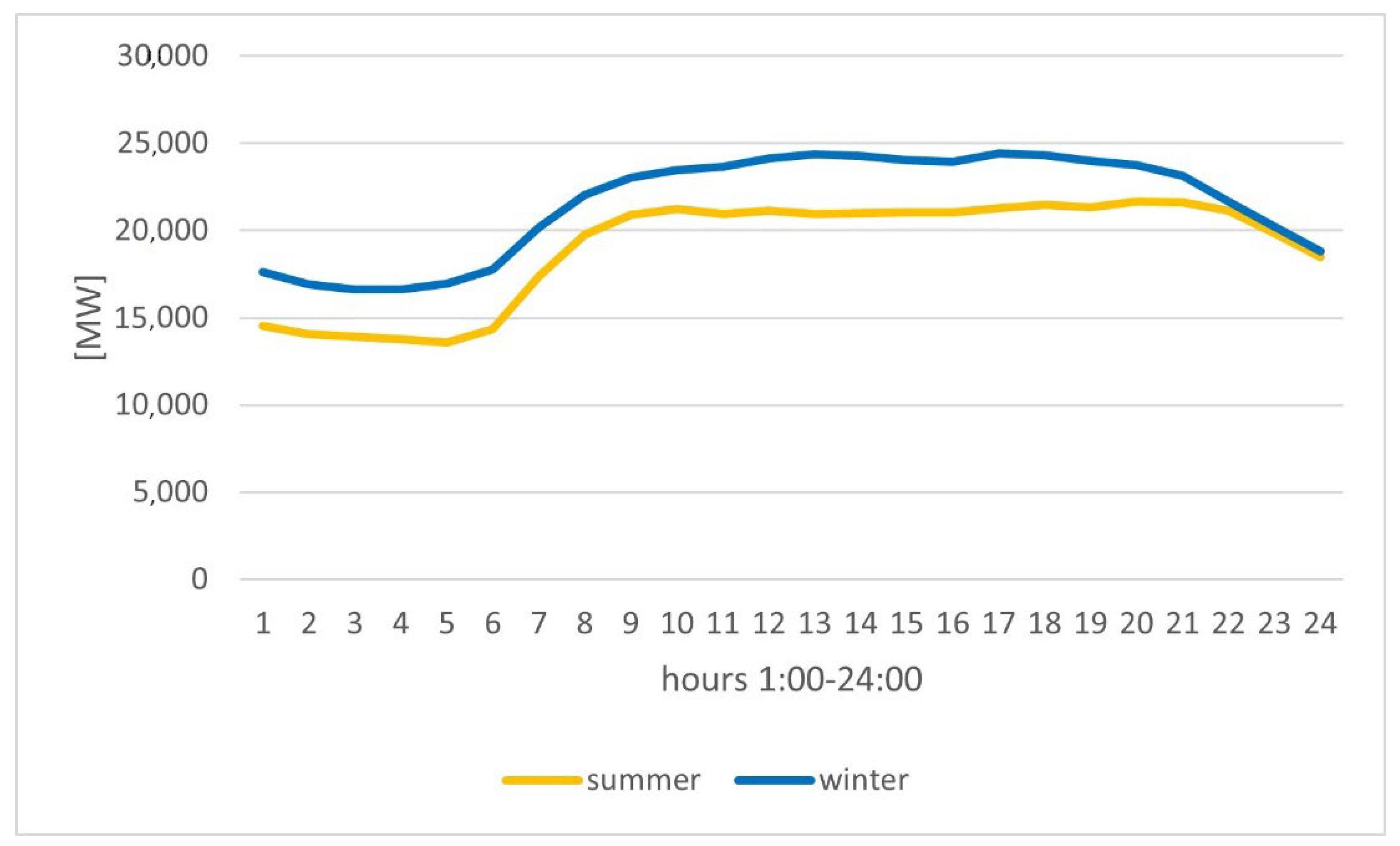Water and Hydropower—Challenges for the Economy and Enterprises in Times of Climate Change in Africa and Europe
Abstract
:1. Introduction
2. Materials and Methods
3. Literature Review
4. Hydro Energy in Africa and Europe
4.1. Water and Electricity Situation in Africa
4.2. Hydro Energy Development in Africa
4.3. Hydro Energy Situation in Europe
5. Hydrological Situation in Poland—Low Water Level
6. Dams/Barrages and Hydroelectric Plants
- Run-of-river power plants without a reservoir—the amount of energy produced by them depends on the amount of water flowing in the riverbed at a given moment;
- Flow control (storage) power plants—in front of the power plant there is a water damming tank;
- Power plants where the water circulation is artificially created—by sequentially pumping water from the lower to the upper reservoir, and then its discharge through the power plant back to the lower reservoir (pumped storage plants).
7. Hydropower in Poland—New Challenges
8. The Energy Aspect of the Planned Investment
9. Conclusions
10. Limitation
Funding
Institutional Review Board Statement
Informed Consent Statement
Data Availability Statement
Conflicts of Interest
References
- Mikulčić, H.; Baleta, J.; Wang, X.; Duić, N.; Dewil, R. Sustainable development in period of climate crisis. J. Environ. Manag. 2022, 303, 114271. [Google Scholar] [CrossRef] [PubMed]
- Borowski, P.F. Nexus between water, energy, food and climate change as challenges facing the modern global, European and Polish economy. AIMS Geosci. 2020, 6, 397–421. [Google Scholar] [CrossRef]
- Polska Jest Jednym z Najuboższych w Wodę Krajów Europejskich. Available online: https://www.national-geographic.pl/artykul/polska-jest-jednym-z-najubozszych-w-wode-krajow-europejskich-pustynnieje-na-naszych-oczach (accessed on 30 September 2022).
- GISS Surface Temperature Analysis. Available online: https://data.giss.nasa.gov/gistemp/graphs_v4/ (accessed on 30 September 2022).
- Bates, B.C.; Kundzewicz, Z.W.; Wu, S.; Palutikof, J.P. (Eds.) Climate Change and Water. In Technical Paper of the Intergovernmental Panel on Climate Change; IPCC Secretariat: Geneva, Switzerland, 2008. [Google Scholar]
- State Drought Monitor. Available online: https://droughtmonitor.unl.edu/CurrentMap/StateDroughtMonitor.aspx?CA (accessed on 30 September 2022).
- Devastating Floods Pakistan. Available online: https://www.unicef.org/emergencies/devastating-floods-pakistan-2022 (accessed on 30 September 2022).
- How Climate Change Impact. Available online: https://education.nationalgeographic.org/resource/how-climate-change-impacts-water-access (accessed on 30 September 2022).
- Water and Climate Change. Available online: https://www.unicef.org/stories/water-and-climate-change-10-things-you-should-know (accessed on 30 September 2022).
- Gemechu, E.; Kumar, A. A review of how life cycle assessment has been used to assess the environmental impacts of hydropower energy. Renew. Sustain. Energy Rev. 2022, 167, 112684. [Google Scholar] [CrossRef]
- Danielsen, E.J.; Jonsson Valderrama, A. Methane and Carbon Dioxide Emissions from Three Smallscale Hydropower Stations in South of Sweden, Digitala Vetenskapliga Arkivet. 2022. Available online: https://www.diva-portal.org/smash/record.jsf?pid=diva2%3A1670113&dswid=356 (accessed on 30 September 2022).
- Scherer, L.; Pfister, S. Hydropower’s Biogenic Carbon Footprint. PLoS ONE 2016, 11, e0161947. [Google Scholar] [CrossRef] [Green Version]
- Hydroelectrics Dams. Available online: https://www.theguardian.com/global-development/2016/nov/14/hydroelectric-dams-emit-billion-tonnes-greenhouse-gas-methane-study-climate-change (accessed on 30 September 2022).
- Bambace, L.; Ramos, F.; Lima, I.; Rosa, R. Mitigation and recovery of methane emissions from tropical hydroelectric dams. Energy 2007, 32, 1038–1046. [Google Scholar] [CrossRef]
- Renewable Electricity. Available online: https://www.iea.org/reports/renewables-2021/renewable-electricity?mode=market®ion=World&publication=2021&product=Total (accessed on 30 September 2022).
- Raport Tamy. Available online: http://eko.org.pl/kropla/21/raport-tamy.htm (accessed on 30 September 2022).
- Park, H.; Kim, W. Water industry: Water-energy-health nexus. Environ. Sci. Pollut. Res. 2019, 26, 1013–1014. [Google Scholar] [CrossRef] [Green Version]
- Taylor, R.G.; Scanlon, B.; Döll, P.; Rodell, M.; Van Beek, R.; Wada, Y.; Longuevergne, L.; Leblanc, M.; Famiglietti, J.S.; Edmunds, M.; et al. Ground water and climate change. Nat. Clim. Chang. 2013, 3, 322–329. [Google Scholar] [CrossRef] [Green Version]
- Stringer, L.C.; Mirzabaev, A.; Benjaminsen, T.A.; Harris, R.M.; Jafari, M.; Lissner, T.K.; Stevens, N.; der Pahlen, C.T.-V. Climate change impacts on water security in global drylands. One Earth 2021, 4, 851–864. [Google Scholar] [CrossRef]
- Pepin, N.C.; Arnone, E.; Gobiet, A.; Haslinger, K.; Kotlarski, S.; Notarnicola, C.; Palazzi, E.; Seibert, P.; Serafin, S.; Schöner, W.; et al. Climate Changes and Their Elevational Patterns in the Mountains of the World. Rev. Geophys. 2022, 60, e2020RG000730. [Google Scholar] [CrossRef]
- Berga, L. The role of hydropower in climate change mitigation and adaptation: A review. Engineering 2016, 2, 313–318. [Google Scholar] [CrossRef]
- Ibrahim, I.; Hamam, Y.; Alayli, Y.; Jamiru, T.; Sadiku, E.; Kupolati, W.; Ndambuki, J.; Eze, A. A review on Africa energy supply through renewable energy production: Nigeria, Cameroon, Ghana and South Africa as a case study. Energy Strat. Rev. 2021, 38, 100740. [Google Scholar] [CrossRef]
- Diallo, T.A. Beyond the Resource Curse: Mineral Resources and Development in Guinea-Conakry. Ph.D. Thesis, Massachusetts Institute of Technology, Cambridge, MA, USA, 2015. [Google Scholar]
- Degefu, D.M.; He, W.; Zhao, J.H. Hydropower for sustainable water and energy development in Ethiopia. Sustain. Water Resour. Manag. 2015, 1, 305–314. [Google Scholar] [CrossRef] [Green Version]
- Salah, S.I.; Eltaweel, M.; Abeykoon, C. Towards a sustainable energy future for Egypt: A systematic review of renewable energy sources, technologies, challenges, and recommendations. Clean. Eng. Technol. 2022, 8, 100497. [Google Scholar] [CrossRef]
- Wagner, B.; Hauer, C.; Habersack, H. Current hydropower developments in Europe. Curr. Opin. Environ. Sustain. 2019, 37, 41–49. [Google Scholar] [CrossRef]
- Borowski, P.F. Digitization, digital twins, blockchain, and industry 4.0 as elements of management process in enterprises in the energy sector. Energies 2021, 14, 1885. [Google Scholar] [CrossRef]
- Rabe, M.; Streimikiene, D.; Drożdż, W.; Bilan, Y.; Kasperowicz, R. Sustainable regional energy planning: The case of hydro. Sustain. Dev. 2020, 28, 1652–1662. [Google Scholar] [CrossRef]
- Igliński, B. Hydro energy in Poland: The history, current state, potential, SWOT analysis, environmental aspects. Int. J. Energy Water Resour. 2019, 3, 61–72. [Google Scholar] [CrossRef] [Green Version]
- List of Continents by GDP. Available online: https://statisticstimes.com/economy/continents-by-gdp.php (accessed on 30 September 2022).
- Kałuża, T.; Hämmerling, M.; Zawadzki, P.; Czekała, W.; Kasperek, R.; Sojka, M.; Mokwa, M.; Ptak, M.; Szkudlarek, A.; Czechlowski, M.; et al. The hydropower sector in Poland: Barriers and the outlook for the future. Renew. Sustain. Energy Rev. 2022, 163, 112500. [Google Scholar] [CrossRef]
- Borowski, P.F.; Patuk, I. Environmental, social and economic factors in sustainable development with food, energy and eco-space aspect security. Present Environ. Sustain. Dev. 2021, 15, 153–169. [Google Scholar] [CrossRef]
- Borowski, P.F. Significance and directions of energy development in African countries. Energies 2021, 14, 4479. [Google Scholar] [CrossRef]
- Africa. Available online: https://www.hydropower.org/region-profiles/africa (accessed on 30 September 2022).
- Elagib, N.A.; Basheer, M. Would Africa’s largest hydropower dam have profound environmental impacts? Environ. Sci. Pollut. Res. 2021, 28, 8936–8944. [Google Scholar] [CrossRef] [PubMed]
- Isaacman, A. Cahora Bassa Dam & the Delusion of Development. Daedalus 2021, 150, 103–123. [Google Scholar]
- Hydropower Dominate Angola. Available online: https://www.power-technology.com/comment/hydropower-dominate-angola-power/ (accessed on 30 September 2022).
- Countries in Africa by Population. Available online: https://www.worldometers.info/population/countries-in-africa-by-population/ (accessed on 30 September 2022).
- GDP by Countries. Available online: https://tradingeconomics.com/ (accessed on 30 September 2022).
- New Guide on Hydropower Investment in Africa Highlights Huge Opportunities. Available online: https://www.hydropower.org/news/new-guide-on-hydropower-investment-in-africa-highlights-huge-opportunities (accessed on 30 September 2022).
- Europe. Available online: https://www.hydropower.org/region-profiles/europe (accessed on 30 September 2022).
- Global Tracking Framework. Available online: https://www.worldbank.org/en/topic/energy/publication/Global-Tracking-Framework-Report (accessed on 30 September 2022).
- Bonn 2011 Conference. Available online: https://sdgs.un.org/events/bonn-2011-conference-water-energy-and-food-security-nexus-water-resources-green-economy-6790 (accessed on 30 September 2022).
- Carbon Dioxide Emission from Electricity. Available online: https://www.world-nuclear.org/information-library/energy-and-the-environment/carbon-dioxide-emissions-from-electricity.aspx (accessed on 30 September 2022).
- Fresh Water Resources. Available online: https://www.climatechangepost.com/poland/fresh-water-resources/ (accessed on 30 September 2022).
- Susza. Available online: https://www.gov.pl/web/susza/susza (accessed on 30 September 2022).
- Zasoby Wody w Polsce. Available online: https://portalstatystyczny.pl/zasoby-wody-w-polsce/ (accessed on 30 September 2022).
- Lee, D.-H.; Kim, N.-W.; Chung, I.-M. Comparison of Groundwater Recharge between HELP Model and SWAT Model. J. Korea Water Resour. Assoc. 2010, 43, 383–391. [Google Scholar] [CrossRef] [Green Version]
- Another Reason for Rising Food Prices. Available online: https://www.barrons.com/articles/another-reason-for-rising-food-prices-droughts-51634806800 (accessed on 30 September 2022).
- Hydroelektrownie Szkodzą Środowisku. Available online: https://www.wwf.pl/aktualnosci/hydroelektrownie-szkodza-srodowisku-i-naszym-finansom (accessed on 30 September 2022).
- Bagher, A.M.; Vahid, M.; Mohsen, M.; Parvin, D. Hydroelectric energy advantages and disadvantages. Am. J. Energy Sci. 2015, 2, 17. [Google Scholar]
- Mari Júnior, A.; Mari, A.G.; Cabral, A.C.; Frigo, E.P.; Santos, R.F. Advantages and disadvantages of hydropower. Acta Iguazu 2013, 2, 20–28. [Google Scholar]
- Zapotrzebowanie Mocy. Available online: https://www.pse.pl/dane-systemowe/funkcjonowanie-kse/raporty-dobowe-z-pracy-kse/zapotrzebowanie-mocy-kse (accessed on 30 September 2022).
- Niechciał, J. Energetyka wodna. In Polska Wobec Świata, Energia Gigawat; AGENT Public Relations: Kraków, Poland, 2014. [Google Scholar]
- Zheng, B.; Qin, Y.; Liu, D.; Norra, S.; Wang, S. Thematic issue: Water environment of the Three Gorges Reservoir. Environ. Earth Sci. 2017, 76, 819. [Google Scholar] [CrossRef] [Green Version]
- Innowacyjny Stopień Wodny Siarzewo. Available online: https://wody.gov.pl/strefa-klienta/114-nieprzypisany/1732-siarzewo-innowacyjny-stopien-wodny (accessed on 30 September 2022).
- Water Law. Available online: https://leap.unep.org/countries/pl/national-legislation/water-law-0 (accessed on 30 September 2022).
- Problemy w Elektrowni Turów. Available online: https://businessinsider.com.pl/finanse/problemy-w-elektrowni-turow-i-belchatow-co-to-oznacza-dla-pge/nky9vjq (accessed on 30 September 2022).
- Poland Czechia Fail to Mend. Available online: https://www.euractiv.com/section/energy/news/poland-czechia-fail-to-mend-divisions-over-turow-coal-mine/ (accessed on 30 September 2022).
- Ma, X.; Wu, D.; Wang, D.; Huang, B.; Desomber, K.; Fu, T.; Weimar, M. Optimizing pumped storage hydropower for multiple grid services. J. Energy Storage 2022, 51, 104440. [Google Scholar] [CrossRef]
- Ruszel, M.; Podmiotko, S. (Eds.) Bezpieczeństwo Energetyczne Polski i Europy Uwarunkowania, Wyzwania, Innowacje; IPE: Rzeszów, Poland, 2019. [Google Scholar]
- Decaix, J.; Gaspoz, A.; Hasmatuchi, V.; Dreyer, M.; Nicolet, C.; Crettenand, S.; Münch-Alligné, C. Enhanced operational flexibility of a small run-of-river hydropower plant. Water 2021, 13, 1897. [Google Scholar] [CrossRef]
- Huang, Y.; Cheng, Z.; Li, L.; Lu, S.; Zhong, J.; Zhang, Q. Smooth Switching Strategy for Hydropower Microgrid with Auxiliary Load Shedding Control. In Proceedings of the International Conference on Artificial Intelligence and Power Engineering, Xishuangbanna, China, 18–20 March 2022; Springer: Cham, Switzerland, 2022; pp. 85–96. [Google Scholar]



| Title of the Paper | Main Ideas/Issue Presented in the Paper |
|---|---|
| Ground water and climate change. | Groundwater plays a key role in maintaining ecosystems. Their importance increases in the era of climate change, because the occurrence of frequent, intense extreme climatic phenomena, such as violent storms, violent rainfall, drier, increases the variability of rainfall, soil moisture and surface waters [18]. |
| Climate change impacts on water security in global drylands. | Water scarcity affects between 1 and 2 billion people worldwide, most of whom live in arid lands. The impact of climatic changes on the condition and safety of water in dry areas includes not only the issues of access to clean water and sanitation, but is also strongly related to many other aspects of sustainable development, such as eliminating hunger and reducing various types of poverty: economic, water, energetic [19]. |
| Climate changes and their elevational patterns in the mountains of the world. | Accelerating changes in the mountain climate, the warming of this climate has a significant impact on the environment, including faster melting of snow and ice which causes depletion of snow and ice reserves in mountain areas. This phenomenon is of key importance for the world’s water supply. Significant climate warming is taking place not only in mountainous but also lowland areas [20]. |
| The role of hydropower in climate change mitigation and adaptation: a review | Hydropower significantly contributes to the reduction of greenhouse gas emissions and affects the security of energy supply to energy networks. High-capacity storage reservoirs are more resistant to changes in water resources, are less vulnerable to climate change and act as a buffer against the negative effects of climate change [21]. |
| A review on Africa energy supply through renewable energy production: Nigeria, Cameroon, Ghana and South Africa as a case study. | In most African countries, a significant proportion of the energy produced comes from fossil fuel-based sources. The top hydropower sector is able to supplement the energy balance in order to meet the demand and reduce energy poverty in individual countries and stimulate the interest in issues related to climate change [22]. |
| Beyond the resource curse: mineral resources and development in Guinea-Conakry | Guinea can develop untapped hydropower capacity to supply industry, private farms as well as mines and the rest of the country. However, despite its natural resources (bauxite, iron ore, diamond, gold and hydropower), Guinea has failed to collect and use these resources for socio-economic development [23]. |
| Hydropower for sustainable water and energy development in Ethiopia. | The main demand for energy comes from the industrial, agricultural and service sectors as well as from growing household consumption. The development of huge hydro-energy projects on major rivers with enormous hydropower potential, hydroelectric power generation will enable the implementation of zero-emission economy plans taking into account the abundant water resources and the multifunctional nature of the hydropower system [24]. |
| Towards a sustainable energy future for Egypt: A systematic review of renewable energy sources, technologies, challenges, and recommendations. | Egypt has abundant renewable energy resources; however, the renewable energy sector has not yet been fully used to produce energy in a sustainable manner. Egypt should devote more effort to combating climate change and focus on meeting its growing energy needs with clean energy technologies. Egypt is the fourth largest country in Africa that produces energy from hydroelectric power plants (2876 MW). However, compared to the rest of the world, Egypt’s hydropower is not significant. In addition, Egypt’s and Sudan’s hydropower capacities will suffer significantly from the operation of the Ethiopian Dam (GERD) [25]. |
| Current hydropower developments in Europe. | The energy system in Europe is characterized by a great variability of energy technologies depending on different national and varying framework conditions. Digital solutions, digital twins are implemented in energy systems in many energy companies. The development of hydropower in Europe is influenced by economic, political and environmental conditions. From energy producers to energy supply companies, everyone is concerned with the protection of the environment in the face of constant changes in the energy sector. Research and innovation in hydropower technology and management across national borders is essential. Hydropower plays a key role in the energy transition [26]. |
| Digitization, digital twins, blockchain, and industry 4.0 as elements of management process in enterprises in the energy sector | Digitization in energy sector enterprises, implementation of innovative technical solutions such as digital twins, implementation of the Industry 4.0 paradigm will contribute to increasing energy efficiency and will allow to meet technical, environmental and social requirements [27]. |
| Sustainable regional energy planning: The case of hydro. | Sustainable energy planning, taking into account the regional use of hydropower, allows to achieve a zero-emission economy in 2050 [28]. |
| Hydro energy in Poland: the history, current state, potential, SWOT analysis, environmental aspects. | Water can be used for energy purposes in heating plants and sewage treatment plants. The technical potential of water power in Poland is relatively large. Hydropower in Poland also allows for small water retention. There is a positive impact of hydropower on the environment. Small hydropower allows you to produce energy and allows for a small retention to prevent steppe Poland [29]. |
| The hydropower sector in Poland: Barriers and the outlook for the future | In Poland, the consequences of the occurring climate changes are becoming more and more noticeable and felt in recent years. These changes cause anomalies such as more and more severe droughts, violent and rapid rainfalls, which affect the economic efficiency of the undertaken hydropower investments. Planned and already implemented new investments in Poland are to limit the effects of droughts (construction of storage reservoirs) [30]. |
| Continent | GDP (Billions of USD) | |
|---|---|---|
| 2020 | 2021 | |
| Asia | 33,095,342 | 36,818,738 |
| North America | 24,122,169 | 26,792,652 |
| Europe | 20,908,694 | 23,481,228 |
| South America | 2,847,121 | 3,254,127 |
| Africa | 2,396,739 | 2,692,597 |
| Oceania | 1,601,607 | 1,894,512 |
| GDP [bn USD] | Energy Capacity [MW] | Population [mln] | Capacity per Capita [W] | |
|---|---|---|---|---|
| Ethiopia | 111 | 4074 | 114.0 | 35.7 |
| Angola | 124 | 3836 | 32.8 | 117.0 |
| South Africa | 411 | 3596 | 59.3 | 60.6 |
| Egypt | 469 | 2876 | 102.3 | 28.1 |
| Democratic Rep. of Congo | 63 | 2760 | 89.5 | 30.8 |
| Zambia | 27 | 2400 | 18.3 | 131.1 |
| Mozambique | 17 | 2216 | 31.2 | 71.0 |
| Nigeria | 504 | 2111 | 206.1 | 10.2 |
| Sudan | 43 | 1923 | 43.8 | 43.9 |
| Morocco | 133 | 1770 | 36.9 | 48.0 |
| GDP [bn USD] | Energy Capacity [MW] | Population [mln] | Capacity Per Capita [W] | |
|---|---|---|---|---|
| Norway | 504 | 32,995 | 5.4 | 6110.2 |
| Turkey | 853 | 30,984 | 84.3 | 367.5 |
| France | 2778 | 25,508 | 65.2 | 391.2 |
| Italy | 1996 | 22,593 | 60.4 | 374.1 |
| Spain | 1390 | 20,409 | 46.7 | 437.0 |
| Switzerland | 807 | 16,881 | 10.0 | 1688.1 |
| Sweden | 604 | 16,478 | 8.6 | 1647.8 |
| Austria | 468 | 14,597 | 9.0 | 1697.3 |
| Germany | 4031 | 11,022 | 83.7 | 131.7 |
| Portugal | 256 | 7193 | 10.1 | 712.2 |
| Continent | Variables | r |
|---|---|---|
| Africa | GDP and energy efficiency | 0.119 |
| GDP and energy efficiency per capita | −0.488 | |
| Europe | GDP and energy efficiency | 0.085 |
| GDP and energy efficiency per capita | −0.452 |
| Challenges and Prospects for the Economy | Challenges and Prospects for Energy Enterprises |
|---|---|
| transition to a low-carbon economy | adaptation to environmental requirements |
| increasing energy production | investing in renewable energy |
| the possibility of faster economic development in terms of ensuring increased demand for energy | implementation of innovative solutions reducing the negative effects of the operation of a hydropower plant |
| increasing energy security | production of cheaper energy |
| minimizing the occurrence of blackout | increase in revenues |
| reducing energy poverty | serving more customers |
| Reservoirs (Name and Location) | River | Year Opened | Total Capacity at Maximum Accumulation [hm3] | Area at Maximum Accumulation [km2] | Hight of Accumulation [m] |
|---|---|---|---|---|---|
| Solina | San | 1968 | 472.4 | 22.0 | 60.0 |
| Włocławek (barrage) | Wisła | 1970 | 453.6 | 75.0 | 12.7 |
| Czorstyn-Nidzica | Dunajec | 1997 | 231.9 | 12.3 | 54.5 |
| Jeziorsko | Warta | 1986 | 202.0 | 42.3 | 11.5 |
| Goczałkowice | Mała Wisła | 1956 | 161.3 | 32.0 | 13.0 |
| Rożnów | Dunajec | 1942 | 159.3 | 16.0 | 31.5 |
| Dobczyce | Raba | 1986 | 141.7 | 10.7 | 27.9 |
| Otmuchów | Nysa Kłodzka | 1933 | 130.5 | 20.6 | 18.4 |
| Nysa | Nysa Kłodzka | 1971 | 124.7 | 20.7 | 13.3 |
| Turawa | Mała Panew | 1938/1948 | 106.2 | 20.8 | 13.6 |
| Type of Drought | Characteristics of Drought |
|---|---|
| Atmospheric drought | It occurs when there is a rainfall deficit. Also known as meteorological drought. This is the first stage of drought development. It occurs when rainfall is below the long-term average or it is completely absent. A direct effect of the deficit in rainfall is the insufficient moisture content that grows over time, which is particularly intense in the warm season, intensifying evaporation and evapotranspiration (climatic indicator showing how quickly evaporation could take place if the availability of water was sufficient). The above leads to a violation of soil and surface water resources. |
| Agricultural drought | It occurs when the soil moisture is insufficient to meet the water needs of plants and for normal farming. Also called soil drought. It is a direct consequence of the prolonged atmospheric drought. Defined as the period when soil moisture is insufficient to meet the needs of plants in the soil profile and to conduct normal agricultural management. It should be noted that not every period without rainfall and a simultaneous decrease in soil moisture is an agricultural drought. The condition for an agricultural drought to occur is the occurrence of changes in the state of vegetation, i.e., the occurrence of water stress symptoms, a decrease in biomass and yield limitations. |
| Hydrological drought | It manifests itself in a long-term reduction in the amount of water in rivers and lakes. Also known as the “hydrological low flow”. Applies to surface waters. It occurs when the flow in rivers drops below the multi-year average value. It is a period of reduced surface water resources as compared to the average value for many years. Hydrological drought is the next stage of increasing atmospheric and agricultural drought. |
| Hydrogeological drought | Drought is defined as a long-term decline in groundwater resources. This type of drought phenomenon is usually preceded by the above types of drought. The initial phase manifests itself, inter alia, in drying outwells. |
| Advantages | Disadvantages |
|---|---|
| The generated energy reduces environmental pollution. Hydropower leaves no waste behind. | Interference with the natural environment is related mainly to the difficulties in the migration of fish aiming at spawning and the elimination of bird breeding sites, which contributes to the reduction of their numbers. |
| It allows saving natural fuels | Contribution to changes in the hydrological structure (e.g., the Three Gorges Dam in China, which slowed down the rotation of the Earth by holding large masses of water) |
| It does not pollute the natural environment with exhaust gases and fluids that are generated in the process of burning non-renewable energy sources. | It causes silting of water reservoirs, and thus reduces their capacity, which during periods of heavy rainfall or thaw may lead to inundation or flooding |
| They can provide flood protection thanks to the possibility of accumulating water in appropriate retention reservoirs | Changing the water level contributes to the occurrence of landslides and bank abrasion |
| They are more efficient than conventional power plants, thanks to which they generate electricity more efficiently | The need to relocate people in the case of building power plants in previously populated areas |
| Damming the water in front of hydroelectric power plants has a positive effect on the hydrological balance and navigation conditions | The construction of a hydropower plant is several times more expensive than the construction of a conventional power plant, and the preparatory process itself is very long |
| Easy and precise control of generated energy | Noise and pollution during construction |
| Support for the local economy (hydroelectric plants provide jobs, which has a positive impact on the local economy | May cause secondary effects in the form of bursting dams and water disasters |
Publisher’s Note: MDPI stays neutral with regard to jurisdictional claims in published maps and institutional affiliations. |
© 2022 by the author. Licensee MDPI, Basel, Switzerland. This article is an open access article distributed under the terms and conditions of the Creative Commons Attribution (CC BY) license (https://creativecommons.org/licenses/by/4.0/).
Share and Cite
Borowski, P.F. Water and Hydropower—Challenges for the Economy and Enterprises in Times of Climate Change in Africa and Europe. Water 2022, 14, 3631. https://doi.org/10.3390/w14223631
Borowski PF. Water and Hydropower—Challenges for the Economy and Enterprises in Times of Climate Change in Africa and Europe. Water. 2022; 14(22):3631. https://doi.org/10.3390/w14223631
Chicago/Turabian StyleBorowski, Piotr F. 2022. "Water and Hydropower—Challenges for the Economy and Enterprises in Times of Climate Change in Africa and Europe" Water 14, no. 22: 3631. https://doi.org/10.3390/w14223631






